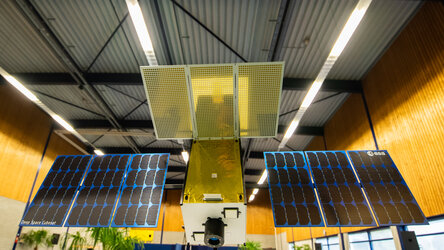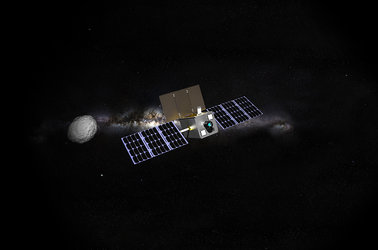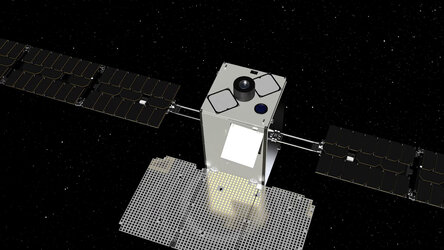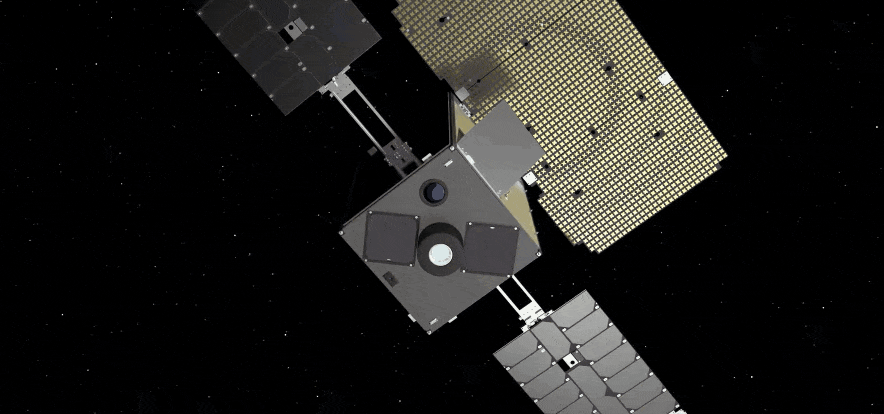Accept all cookies Accept only essential cookies See our Cookie Notice

About ESA
The European Space Agency (ESA) is Europe’s gateway to space. Its mission is to shape the development of Europe’s space capability and ensure that investment in space continues to deliver benefits to the citizens of Europe and the world.
Highlights
ESA - United space in Europe
This is ESA ESA facts Member States & Cooperating States Funding Director General Top management For Member State Delegations European vision European Space Policy ESA & EU Space Councils Responsibility & Sustainability Annual Report Calendar of meetings Corporate newsEstablishments & sites
ESA Headquarters ESA ESTEC ESA ESOC ESA ESRIN ESA EAC ESA ESAC Europe's Spaceport ESA ESEC ESA ECSAT Brussels Office Washington OfficeWorking with ESA
Business with ESA ESA Commercialisation Gateway Law at ESA Careers Cyber resilience at ESA IT at ESA Newsroom Partnerships Merchandising Licence Education Open Space Innovation Platform Integrity and Reporting Administrative Tribunal Health and SafetyMore about ESA
History ESA Historical Archives Exhibitions Publications Art & Culture ESA Merchandise Kids Diversity ESA Brand Centre ESA ChampionsLatest
Space in Member States
Find out more about space activities in our 23 Member States, and understand how ESA works together with their national agencies, institutions and organisations.
Science & Exploration
Exploring our Solar System and unlocking the secrets of the Universe
Go to topicAstronauts
Missions
Juice Euclid Webb Solar Orbiter BepiColombo Gaia ExoMars Cheops Exoplanet missions More missionsActivities
International Space Station Orion service module Gateway Concordia Caves & Pangaea BenefitsLatest
Space Safety
Protecting life and infrastructure on Earth and in orbit
Go to topicAsteroids
Asteroids and Planetary Defence Asteroid danger explained Flyeye telescope: asteroid detection Hera mission: asteroid deflection Near-Earth Object Coordination CentreSpace junk
About space debris Space debris by the numbers Space Environment Report In space refuelling, refurbishing and removingSafety from space
Clean Space ecodesign Zero Debris Technologies Space for Earth Supporting Sustainable DevelopmentLatest
Applications
Using space to benefit citizens and meet future challenges on Earth
Go to topicObserving the Earth
Observing the Earth Future EO Copernicus Meteorology Space for our climate Satellite missionsCommercialisation
ESA Commercialisation Gateway Open Space Innovation Platform Business Incubation ESA Space SolutionsLatest
Enabling & Support
Making space accessible and developing the technologies for the future
Go to topicBuilding missions
Space Engineering and Technology Test centre Laboratories Concurrent Design Facility Preparing for the future Shaping the Future Discovery and Preparation Advanced Concepts TeamSpace transportation
Space Transportation Ariane Vega Space Rider Future space transportation Boost! Europe's Spaceport Launches from Europe's Spaceport from 2012Latest

M–Argo
Thank you for liking
You have already liked this page, you can only like it once!
ESA has designed its first stand-alone CubeSat mission for deep space – aimed at targeting a little- known class of asteroid: small in size and rapidly spinning.
Studied in the Concurrent Design Facility, ESA’s highly networked facility for designing novel missions, the ‘Miniaturised – Asteroid Remote Geophysical Observer’, or M–Argo, is a nano-spacecraft based on the CubeSat design employing standardised 10 cm cubic units within which electronic boards can be stacked and subsystems attached.
M–ARGO would be a 12-unit CubeSat – with bodily dimensions of 22 x 22 x 34 cm – that would hitch a ride on the launch of a larger space mission whose trajectory takes it close to beyond Earth orbit – such as large astronomy missions to a Sun–Earth Lagrange point.
The CubeSat would then use its own high-efficiency electric propulsion system to take it into deep space and rendezvous with an asteroid target.
“CubeSats were originally developed for educational purposes, but they have become a cheap and fast method of demonstrating space technologies,” comments Roger Walker, overseeing ESA’s Technology CubeSats.
“Having shown their worth in low-Earth orbit we have been studying their use further afield, starting with CubeSats for ESA’s proposed Asteroid Impact Mission and then the Moon.
“But these CubeSat studies assumed the availability of a nearby ‘mothership’ to be relied on for transportation and then communication home. M–Argo by contrast would be completely stand-alone in nature.
“Our CDF study shows the concept is promising and would have a high potential of cutting the entry-level cost of deep-space exploration by about a factor of ten.”
The study confirmed a total of four separate asteroids the CubeSat could reach under its own power – and potentially up to 30 in total – as Roger explains: “They are all less than 50 m in diameter – half the length of a football field – and all rapidly spinning, modelled accordingly to have no remaining surface dust but instead to be monolithic in nature.
“So this would be a quite new type of planetary body to visit, thereby offering the potential for new scientific discoveries.”
M–ARGO would spend around six months surveying its target, using two miniaturised instruments: a multispectral imager and a laser altimeter.
Data would be returned using a specially designed transponder and high-gain antenna array, communicating with existing 15-35 m ESA-operated ‘Estrack’ ground stations, with the potential to be backed up by Italy’s larger 64-m diameter Sardinia Radio Telescope for a greater data return.
M–Argo could be ready launch in mid-2021 at the earliest, assuming that some key technology development starts soon. Most of its key technologies are already available, and the study pinpointed other R&D needed to make it possible – including a CubeSat-sized solar array drive mechanism, electric propulsion and X-band communications, plus radiation hardness of components – to be performed within ESA technology programmes.
The study also considered an alternative mission concept for M–ARGO, as a space weather observatory placed at the Sun–Earth L5 Lagrange Point, hosting a radiation monitor and boom-based magnetometer instrument.
The next step will be to start the key technology developments and find a suitable flight opportunity. Then afterwards the main mission and system definition phase could commence.
While the M-Argo concept is studied, ESA will be marking 30 June, Asteroid Day, and spreading the word on the tiny bodies that Earth shares space with, as both a scientific resource and a potential danger. For more information on Asteroid Day click here.
-
CREDIT
©ESA-Jacky Huart -
LICENCE
ESA Standard Licence

M-Argo

Deep-space CubeSat

M-Argo: ESA's asteroid-targeting CubeSat

Getting CubeSats moving















 Germany
Germany
 Austria
Austria
 Belgium
Belgium
 Denmark
Denmark
 Spain
Spain
 Estonia
Estonia
 Finland
Finland
 France
France
 Greece
Greece
 Hungary
Hungary
 Ireland
Ireland
 Italy
Italy
 Luxembourg
Luxembourg
 Norway
Norway
 The Netherlands
The Netherlands
 Poland
Poland
 Portugal
Portugal
 Czechia
Czechia
 Romania
Romania
 United Kingdom
United Kingdom
 Slovenia
Slovenia
 Sweden
Sweden
 Switzerland
Switzerland
























